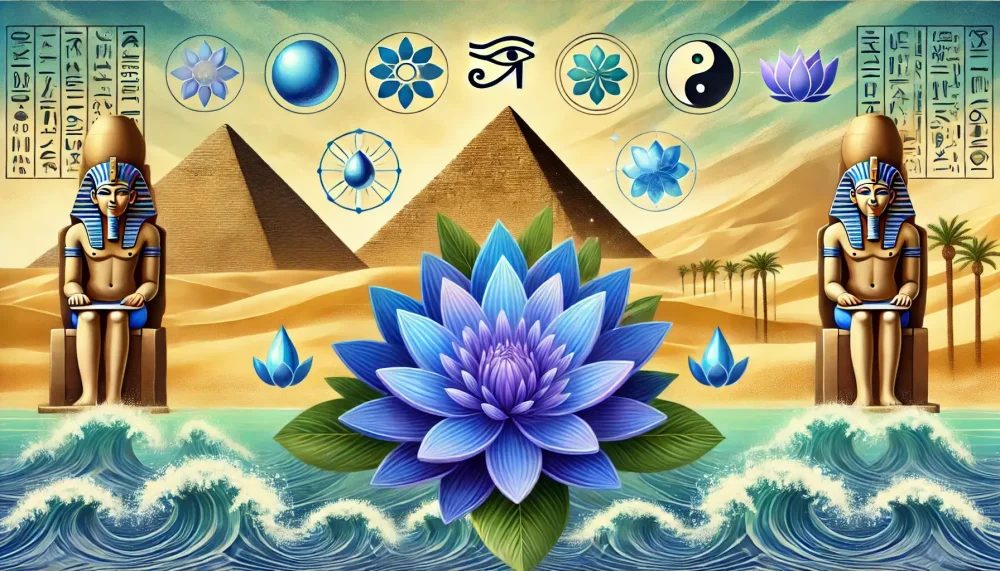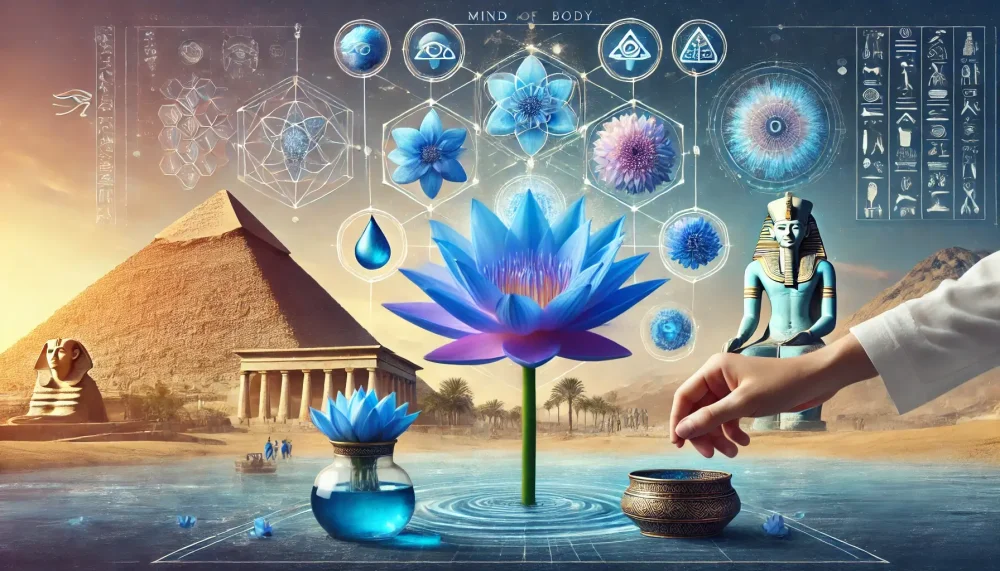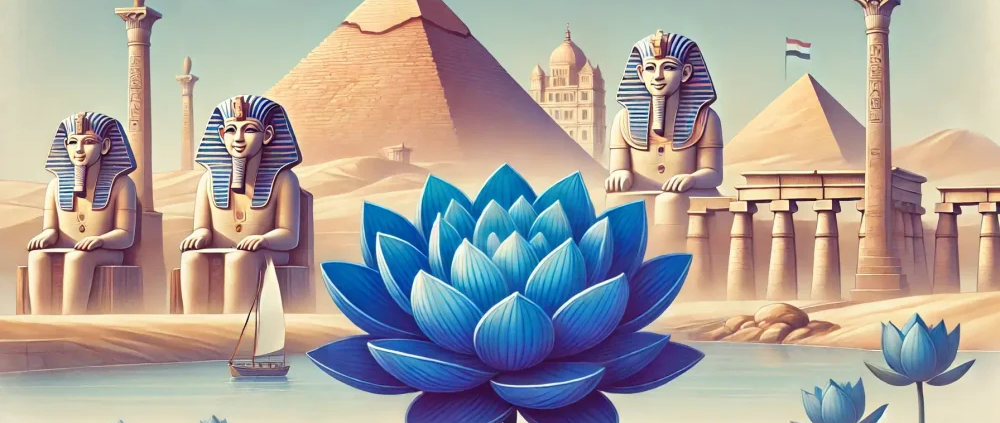The Blue Lotus: the magical plant of the ancient Egyptians that captivates to this day
- What is a blue lotus?
- Spiritual effects of the blue lotus or what did the ancient Egyptians know?
- Blue lotus: effects and benefits
- How does the blue lotus work?
- Teas, flowers and prerolls
- Conclusion
What is a blue lotus?
The blue lotus (Latin: Nymphaea Caerulea) is a rare aquatic plant with striking blue petals that grows in the muddy shallow waters of the Nile River in Egypt. You may know it by many names – blue water lily, intuition flower, Egyptian lotus or sacred blue Nile lily.
In ancient Egypt, the blue lotus was revered as a sacred and medicinal plant with deep spiritual and symbolic meaning. Thanks to its psychoactive effects, it played a key role in religious ceremonies and shamanic rituals.
Spiritual effects of the blue lotus or what did the ancient Egyptians know?
We will stop for a moment at ancient Egypt. The Egyptians believed that the smell and consumption of the blue lotus could induce states of ecstasy, provide a connection to the divine world and open a gateway to the afterlife. It was therefore often used in funeral ceremonies to help the deceased on their journey to the underworld and spiritual rebirth.
In addition to its spiritual significance, the blue lotus was also popular for its medicinal properties. Ancient physicians used it as a means of detoxifying the body or calming the mind and body. Its extracts were included in many elixirs and were widely used to treat insomnia, pain or poisoning.

The sacred flower also symbolized fertility and sexual vitality, as evidenced by the many surviving frescoes with love scenes. During ceremonies of elite society, wine enriched with its extract was served to stimulate erotic experiences and increase arousal. It was also added to perfumes and oils to stimulate the senses.
The importance of the legendary plant in Egyptian culture is confirmed by its discovery in the tomb of the famous Pharaoh Tutankhamun, and it is even mentioned in the Egyptian Book of the Dead, one of the most important historical artifacts of this civilization.
From the Egyptians’ treatment of the blue lotus, much can be inferred for the present day. Let’s take a look.
Blue Lotus: Effects and Benefits
Blue lotus is a versatile plant with a range of benefits and a wide spectrum of effects that are often likened to CBD or kratom. Nowadays, blue lotus is especially known for its relaxing, meditative and aphrodisiac effects:
- Natural relaxant: It has a euphoric effect, relaxes the whole body, induces feelings of well-being and can potentially contribute to stress relief. The plant also has sedative properties and serves as a possible means of improving sleep quality – it may promote faster falling asleep and increase the length of deep sleep.
- Meditation aid: in the experience of users, it can assist in deeper immersion in meditation and induce lucid dreaming, i.e. conscious dreaming in which the individual has control over and can influence their dreams. This plant is also considered to help open the third eye, a symbol for intuition and spiritual insight.
- Aphrodisiac: It is claimed to promote an increase in libido and improve the experience of sexual intimacy. The plant’s gentle sedative effects can also reduce inhibitions and develop physical and emotional connection between partners.
Adverse side effects that blue lotus may cause include, but are not limited to:
- Confusion
- Dizziness
- Dry mouth
- Nausea and vomiting
- Indistinct speech
- Chest pain
- Sleepiness
How does the blue lotus work?
The two key substances responsible for the psychoactive and potentially medicinal properties of blue lotus are apomorphine and nuciferin:
- Apomorphine: a psychoactive compound that acts as a dopamine agonist, meaning it can induce feelings of happiness and euphoria. It can also help with muscle control in people with conditions such as Parkinson’s disease.
- Nuciferine: a compound thought to act as an antipsychotic that induces feelings of calm through as yet not fully understood mechanisms. It has also been associated with improvement of erectile dysfunction symptoms and weight loss.
In addition, blue lotus flower contains antioxidants such as flavonoids, quercetin, kaempferol and myricetin.
Antioxidants neutralize free radicals, which are harmful molecules that can damage cells and cause disease. This reduces the risk of oxidative stress, which can lead to chronic diseases such as heart disease, diabetes and some cancers, according to studies. No research has yet confirmed a direct link between blue lotus and these diseases.
However, due to its antioxidant properties, blue lotus is gaining increasing popularity in the cosmetic industry. While there is no direct scientific evidence of the plant’s effect on skin health, it could potentially improve skin elasticity, balance sebum production, which may help prevent acne, or help relieve other skin problems and inflammation.

Teas, flowers and prerolls
In European Union countries, blue lotus is not officially approved as a food or dietary supplement under current legislation. For this reason, it is not intended for consumption, smoking or vaping, either alone or mixed with other substances. It is sold for collecting purposes only.
Collectors especially appreciate the exotic appearance and historical significance of the blue lotus. The deep blue to purple flowers that are characteristic of this plant bring unique aesthetic value to collections. For many, it also has significance as a symbol of revival, spirituality and enlightenment of the ancient Egyptian civilisation.
Blue lotus is available on the market for collectors in a variety of forms, including dried flowers, tea blends or handy prerolls, in which dried blue lotus flowers are hand or machine wrapped in paper, much like cigarettes or cigars.
Essential oils or blue lotus extracts are also a great choice, as they can add another sensory dimension to collections thanks to their beautiful scent.
Conclusion
The blue lotus (Nymphaea caerulea) is a rare plant with a rich history, revered in ancient Egypt for its relaxing, meditative and aphrodisiac effects. It contains apomorphine, which induces euphoria and feelings of happiness, and nuciferine, which has calming effects and may promote sexual vitality. It is also considered to be a natural relaxant that can relieve stress and aid in better sleep. According to users, blue lotus also promotes deeper meditation and lucid dreaming. In European countries, it is sold for collecting purposes only, in the form of teas, dried flowers, extracts, oils or prerolls.
Author: Pavla Skřivánková
Photo: AI
“All information provided on this website, as well as information provided through this website, is for educational purposes only. None of the information contained herein is intended to be a substitute for a medical diagnosis and should not be considered medical advice or recommended treatment. This website does not endorse, condones or advocate the licit or illicit use of narcotic drugs or psychotropic substances or the commission of any other illegal activity. For more information, please see our Disclaimer .”


